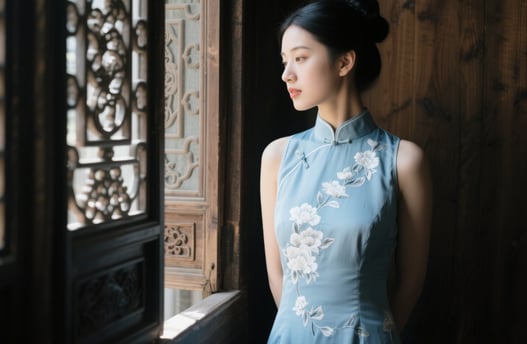Is qipao a Hanfu
The qipao is not Hanfu, as they originate from distinct historical and cultural contexts. The qipao emerged in the Qing Dynasty as Manchu attire, emphasizing practicality and structure, while Hanfu dates back millennia to the Han Dynasty, reflecting Confucian ideals of modesty and fluidity.
QIPAO KNOWLEDGE
6/27/20252 min read


Historical Origins: Separate Lineages
The qipao emerged in the 17th century as the official attire of Manchu women during the Qing Dynasty (1644–1912). Its name literally means "banner gown," referencing the banners (qi) under which Manchu soldiers and their families were organized. Characterized by a straight, ankle-length silhouette, flat collar, and side slits, the qipao was designed for practicality on horseback, reflecting the nomadic roots of the Manchu people. In contrast, Hanfu, which dates back over three millennia to the Han Dynasty (206 BCE–220 CE), embodies the sartorial traditions of the Han Chinese. Rooted in Confucian ideals of modesty and harmony, Hanfu features flowing layers, wide sleeves, and a cross-collar closure, symbolizing the agricultural and sedentary lifestyle of ancient China.
Cultural Symbolism: Contrasting Ideologies
The qipao and Hanfu also represent divergent cultural philosophies. Hanfu, with its loose, unstructured form, mirrors the Daoist emphasis on naturalism and the body’s integration with the cosmos. Its layers and belts historically signified social status and ritual purity. The qipao, however, evolved under Qing Dynasty policies that enforced Manchu dress codes on the Han population, symbolizing political subjugation. Yet, in the 20th century, the qipao underwent a dramatic transformation in Shanghai, becoming a symbol of modernity and female empowerment. Shortened to the knee, fitted to accentuate the figure, and often adorned with Western-style collars and buttons, it became the uniform of the "New Woman" (xinyue nü)—a departure from both its Manchu origins and Hanfu’s conservative ethos.
Design Aesthetics: Form vs. Fluidity
Structurally, the qipao and Hanfu are antitheses. Hanfu prioritizes fluidity and volume, with garments like the ruqun (襦裙, a blouse-and-skirt ensemble) and shenyi (深衣, a one-piece robe) draping loosely to conceal the body’s contours. This reflects Confucian ideals of modesty and the fusion of human form with nature. The qipao, by contrast, emphasizes structure and fit. Its close-fitting, high-necked design, often paired with cheongsam-style frogs (盘扣), highlights the wearer’s silhouette—a radical departure from traditional Chinese aesthetics. This contrast underscores the qipao’s hybrid identity: while it incorporates Chinese elements like frog fastenings and silk brocades, its silhouette and tailoring techniques were influenced by 1920s Western fashion.
Modern Revivalism: Debates and Misconceptions
In recent years, the Hanfu movement has sought to reclaim pre-Qing Dynasty clothing as the sole legitimate "traditional" attire, often excluding the qipao from this category. Proponents argue that Hanfu represents an unbroken lineage of Han Chinese culture, whereas the qipao is a product of Manchu rule and later Westernization. However, this binary perspective overlooks the qipao’s complex history. While it is not Hanfu, it is undeniably a Chinese garment—one that reflects the nation’s tumultuous 20th-century encounters with modernity, colonialism, and feminism.
Conclusion: A Tapestry of Coexistence
To label the qipao as Hanfu would be historically inaccurate, as the two garments emerged from distinct cultural and political contexts. However, to frame them as adversaries is equally reductive. The qipao and Hanfu represent complementary threads in China’s sartorial heritage: one embodying the resilience of Han cultural traditions, the other the nation’s capacity for adaptation and reinvention. In an era of renewed cultural pride, recognizing their differences—and shared significance—offers a richer understanding of China’s multifaceted identity.
In essence, the qipao is not Hanfu, but it is no less Chinese.
The question of whether the qipao (旗袍) qualifies as a form of Hanfu (汉服) reflects broader debates about cultural identity, historical continuity, and the evolution of traditional Chinese clothing. To address this, one must delve into the distinct histories, cultural contexts, and design philosophies of these garments.


